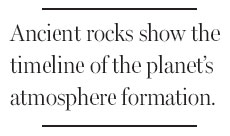Earth's abundance of oxygen, and how it arrived
Updated: 2013-10-20 08:02
By Carl Zimmer(The New York Times)
|
|||||||
To Donald E. Canfield, there's something astonishing in every breath we take. "People take oxygen for granted because it's just there and we breathe it all the time," said Dr. Canfield, a geochemist at the University of Southern Denmark. "But we have the only planet we know of anywhere that has oxygen on it."
What's even more astonishing is that the earth started out with an oxygen-free atmosphere. It took billions of years before there was enough of it to keep animals like us alive.
And scientists are still making discoveries. Recently Dr. Canfield and his colleagues published a pair of studies that provide significant clues about some of the most important chapters in oxygen's history. They're finding that our atmosphere is the result of a complicated dance of geology and biology.
To study the ancient atmosphere, geochemists examine the chemical fingerprints left behind on rocks. Some rocks contain molecules that could have formed only in the presence of oxygen.
When they look at the oldest rocks on earth, they find no trace of oxygen in the atmosphere. Their research indicates that earth's primordial air was made up mostly of carbon dioxide, methane and nitrogen. The sun's rays created some free oxygen by splitting it off from carbon dioxide and other molecules. But the oxygen disappeared almost as soon as it was formed.
That's because oxygen is an enormously friendly element, forming bonds with a wide range of molecules. It attached to the iron in rocks, for example, creating rust. Our planet, in other words, was a giant oxygen vacuum in its early years.
That changed about three billion years ago. In the September 26 issue of Nature, Dr. Canfield and his colleagues reported the fingerprints of oxygen in rocks from that time period. They estimate that the atmosphere had only 0.03 percent of today's oxygen levels. That may not sound like much, but it marked a huge shift in the earth's chemistry.
Sunlight alone couldn't have put that much oxygen in the atmosphere. Only life could.
Some microbes had evolved the ability to carry out photosynthesis. Floating at the surface of the ocean, they used energy from sunlight to grow on carbon dioxide and water. They gave off oxygen as waste. Much of the oxygen released by these photosynthetic microbes was sucked out of the atmosphere by the earth's vacuum. When microbes died, oxygen reacted with their carbon.
But a tiny amount of oxygen remained behind because some of the organic matter from the dead microbes sank from the surface of the ocean to the sea floor, where oxygen couldn't react with it. The oxygen remained in the air.

Oxygen remained fairly scarce for the next few hundred million years. But during that time, the earth's vacuum was getting weak. The planet was cooling, and so its volcanoes spewed less hydrogen into the atmosphere to suck up oxygen.
In his new book, "Oxygen: A Four Billion Year History," Dr. Canfield suggests that this weak vacuum drove a sudden climb in oxygen that geochemists see in rocks from about 2.3 billion years ago. "Now we get to the point where the earth has calmed down enough that the balance has tipped in the favor of oxygen," he said.
Reporting recently in The Proceedings of the National Academies of Sciences, Dr. Canfield said there was so much oxygen in the atmosphere that it penetrated down 300 meters into the ocean. Dr. Canfield says oxygen may have become as abundant as it is today, at least for a while.
But this boom created its own bust. Microbes rained down onto the sea floor, creating carbon-rich rocks. Later, the rocks were lifted up to form dry land, where they could react with the oxygen, pulling it out of the atmosphere. Life itself, in other words, turned earth's vacuum back up again.
Life and earth have continued to fiddle with the oxygen knob over the past two billion years.
As Dr. Canfield gets better acquainted with earth's tumultuous history, he gets less certain about its future.
"I'm not sure we have a good prediction," Dr. Canfield said. "That depends a lot on the vagaries of geography."
The New York Times

(China Daily 10/20/2013 page11)